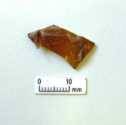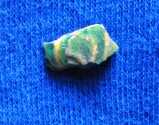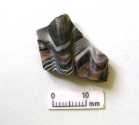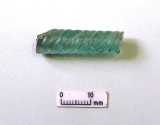
Catalogue Number 3: 'zarte Rippenschalen'
The recognisable beaker and cup forms from contexts of this phase are all early in type, and are blown vessels rather than cast and ground. Catalogue no. 2 is a ‘Convex cup with wheel-cutting and abrasion’, usually called the Hofheim Cup (Price and Cottam 1998, 71-73, fig. 72), and no. 3 is almost certainly a ‘Trailed ribbed cup’, usually referred to by its German name, zarte Rippenschalen (Price and Cottam 1998, 67-68, fig. 18). Both belong to the middle years of the 1st century AD, the former having a range of AD 43-75, the latter c. AD 43–AD 60/65. Hofheim cups tend to be more numerous than the more complicated polychrome ribbed cups, but both are fairly well represented among finds from southern Britain.

Catalogue Number 3: 'zarte Rippenschalen'
The other piece of fine tableware here, albeit represented by only a very small fragment, is the facet-cut fragment, no. 4, which is most likely to have come from a ‘Conical beaker with ground exterior surfaces and facet-cut decoration’ (Price and Cottam 1998, 80-83, fig. 26).
There is one more colourless beaker fragment (no. 5) and one beaker or bowl of blue-green glass (no. 6) whose exact form cannot be identified.
The small fragments of blue glass with opaque marvered blobs (no. 7) are perhaps most likely to be from a jug with a globular body and open cut-out base-ring – either Price and Cottam 1998, 149-50, fig. 65 or 150-52, fig. 66. Both types are occasionally made with opaque white marvered blobs, the former dating from c. AD 43-Flavian, the latter from the Flavian period to the early 2nd century AD. The polychrome decoration dates it more certainly to the 1st century.
Another fine jug is likely to be represented by the rim fragments with pinched trail, no. 1. (NB it is just possible that the fragments catalogued as no. 34 belong to the same vessel – or one very similar.) The general type is the ‘Globular jug with pinched-in spout’, of which some examples were made with a pinched decoration around the rim and over the handle (Price and Cottam 1998, 157-59, fig. 69). A fine complete example of the latter came from a Flavian cremation burial at Colchester (Allen 1998, fig. 20, 5).
There are two probable examples of the type of long-necked jug with either globular or conical body which was very popular during the last quarter of the 1st and the first quarter of the 2nd centuries (Price and Cottam 1998 150-57, figs 66-68: body fragment nos 8-9 are most likely to represent conical jugs of this type. Closely related to these are globular jars with folded tubular rims, and often ribbed bodies – no. 10 represents this form, which dates to the same period.
There were ten bottle fragments from these Objects, three of which are from cylindrical vessels (Price and Cottam 1998, 191-94, fig. 88) and one is from a square bottle (Price and Cottam 1998, 194-98, fig. 89). These were common during the 1st and 2nd centuries, with the cylinders going out of use before the squares.
There is also just one fragment of matt-glossy window glass, of the type made until c. AD 300 (from context 5585, Object 50010).
There are three fragments of cast and ground glass – that is, made by slumping a monochrome or polychrome disc of glass over a former, and polishing and grinding to finish. No. 20 is a pillar-moulded bowl of blue-green glass, probably the commonest form and colour of this general vessel type (Price and Cottam 1998, 44-46, fig. 7). These were very common until the end of the 1st century AD, and continued in use into the 2nd century too. No. 8 may be from a cast and ground ‘bowl with a base-ring’, although only the rim survives – these date from the late 1st to the late 2nd centuries (Price and Cottam 1998, 53-55, fig. 12). No. 28 is a tiny chip of polychrome glass, too small to identify the form, although the colour combination of an emerald green ground with yellow spiral is a common one. These were made until some time during the early Flavian period, and often survive into later 1st century contexts.

Catalogue Number 28: Polychrome glass, emerald green with yellow spiral
There is also a very small fragment of colourless glass with facet-cutting, probably representing a Flavian–Trajanic beaker of the type described in relation to no. 4 above. There are also fragments from two more colourless glass beakers, whose exact forms cannot be identified, but show the presence of finer drinking vessels on the site (nos 21 and 29).
Three examples (nos 31, 33, 34) of cylindrical bowls with tubular rims (Price and Cottam) 1998, 78-80, fig. 25) are present, another common type of the later 1st and 2nd centuries. Larger shallow bowls with out-splayed tubular rims (Price and Cottam 1998, 110-11, fig. 44) are likely to be represented by fragment 30 - a long-lived form which seems to span the 2nd to 4th centuries.
There are several examples of the common long-necked jugs described above with reference to nos 8-9: 17, 18, 19, 37, 38 are body fragments, 26 a handle, made variously of blue-green glass or the strong monochrome colours popular for these vessels. Nos 14 and 15 are base fragments which may be from jugs or the closely related jars, and no. 24 is a rim fragments of this jar form.
There are four other fragments which are likely to represent some form of jug or flask, whose exact type cannot be identified: nos 22, 23, 25 and 36.
Two fragments of unguent bottles, nos 27 and 35, are of the tubular (Price and Cottam 1998, 169-70, fig. 75) or conical form (Price and Cottam 1998, 172-74, fig. 77), in use from the 1st century to the first quarter of the 2nd century.
There were 72 bottle fragments from these Objects, of which 8 are from cylindrical vessels, 7 from square bottles, and 21 can be identified as coming from prismatic bottles, which may be square, hexagonal, rectangular or octagonal. Nos 39 and 40 are substantial fragmentary remains of two square bottles.
One probable fragment of matt-glossy window glass came from context C3521, Object O50037.
A fragmentary annular blue-green glass is the only one from this assemblage – a common type which cannot be closely dated (FSF04023, C3646 (16).

Catalogue Number 41: Marbled pillar-moulded bowl fragment
Two fragments of cast and ground glass, both pillar-moulded-bowls, one monochrome and one an unusual polychrome combination, are likely to be residual from 1st-century contexts: nos 41 and 42.
There is one examples of a tubular-rimmed bowl (no. 45), as described in relation to nos 31, 33, 34) and one example of a bowl with outsplayed tubular rim (no. 44) also described above. No. 44 is made of colourless glass, which is less common than the blue-green form, but by no means unknown.
There are two fragments, probably from the same vessel (no. 46) of a bowl with horizontal fold in the body (Price and Cottam 1998, 109-10, fig. 43), Dated examples have been found in contexts which range from the later 2nd to the 4th centuries.
There is one other fragment of a colourless beaker, no. 46, whose exact form cannot be identified.

Catalogue Number 51: Elegant handle of long-necked jug
The common long-necked jugs of later 1st–2nd century date are represented by a handle fragment, no. 48, and body fragments, no. 50. Other handle and body fragments likely to be from jugs or flasks cannot be identified precisely: nos 47, 49, 51, 52, 53, 54.
There were 18 bottle fragments from this Object, of which four are from cylindrical vessels, one from a square bottle, and six can be identified as coming from prismatic bottles, which may be square, hexagonal, rectangular or octagonal.

Catalogue Number 55: Twisted rod
One piece of a twisted rod of blue-green glass may be from a pin or a stirring rod: no. 55. These were fairly common throughout the Roman period.
© Internet Archaeology
URL: http://intarch.ac.uk/journal/issue21/4/finds_glass.htm
Last updated: Wed Sept 12 2007